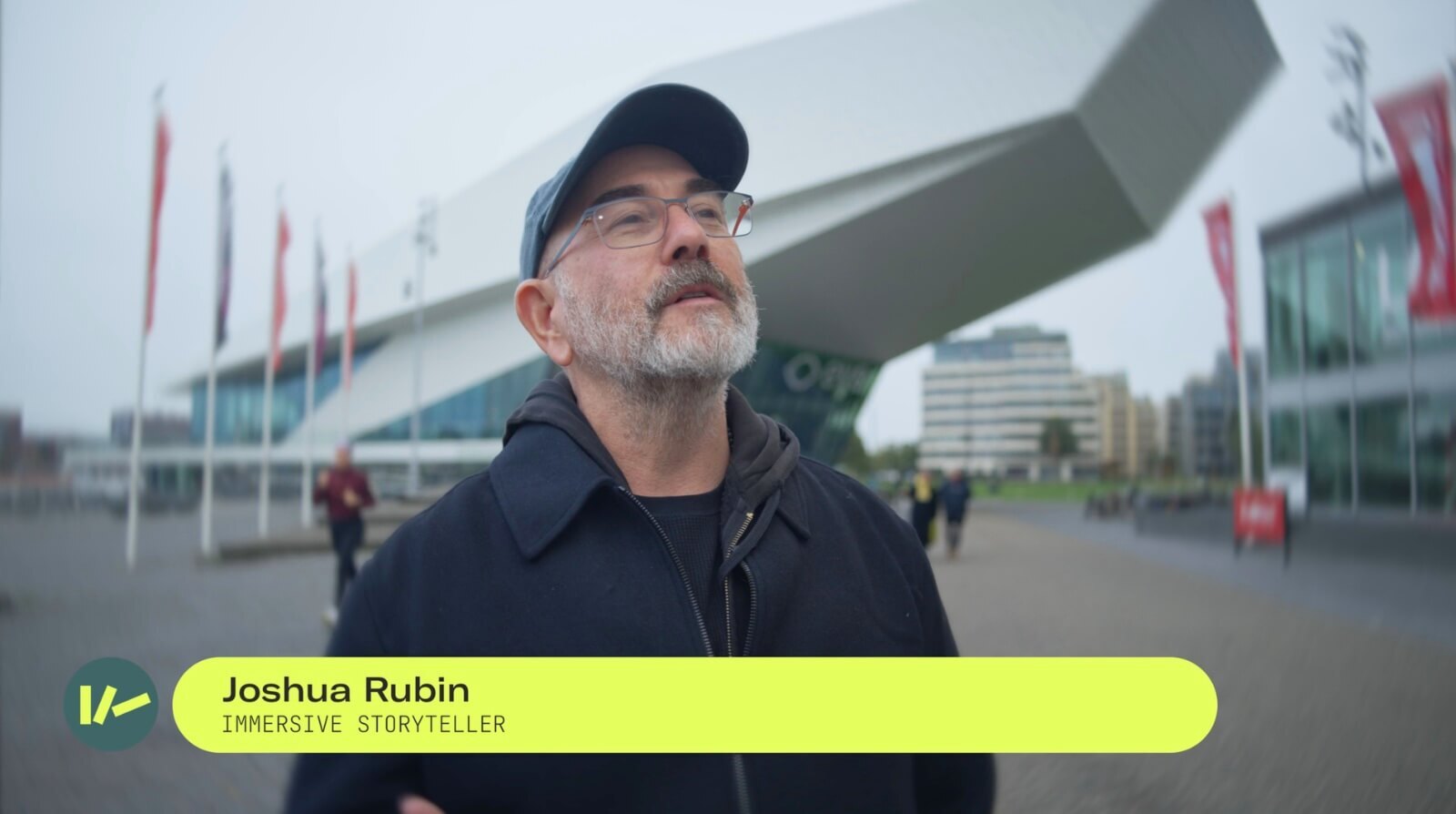
The future of stories we not only watch but experience: Joshua Rubin's vision of radical choice freedom in interactive storytelling (video)
What if you could tell Netflix you want a cyberpunk adventure starring Jennifer Lawrence and Humphrey Bogart, then step into that world and actually live it—not as a passive viewer, but as someone whose choices reshape the story as it unfolds around you? This may not be science fiction anymore – even if today’s technology doesn’t quite allow for such levels of interactive immersion just yet.
According to Emmy-winning interactive narrative director Joshua Rubin, the convergence of AI, VR, and lessons from 150 years of immersive theater is bringing us closer to this reality than ever before. The question isn't whether it will happen, but whether we'll build these worlds as meaningful playgrounds for human connection or descend into what he calls "AI dystopian slop."
On the morning of Friday, October 3rd, CIIIC and theDutch Games Association hosted an exclusive masterclass with Rubin at EYE Filmmuseum in Amsterdam. Drawing from his 25-30 years creating interactive experiences—from Assassin's Creed 2 and Destiny to The Walking Dead and his current work as narrative lead on Orion Drift—Rubin explored the central tension facing interactive storytelling: how to give players radical freedom while still delivering the structure and catharsis that make stories meaningful. Through examples spanning video games, immersive theater, VR experiences, and emerging AI characters, he laid out a framework for "story living"—experiences defined by radical agency, hyper-reactivity, and deep personalization.
View the video
The Vision: Beyond Passive Entertainment
Rubin opened with his fantasy of telling Netflix he wants a cyberpunk adventure starring Jennifer Lawrence and Humphrey Bogart, then entering that world through VR goggles—not just watching, but making meaningful choices that dynamically reshape the story. This isn't the dystopian "AI slop" of Brave New World's feelies, but rather the holodeck fantasy Janet Murray described in Hamlet on the Holodeck: well-told, interactive stories personalized for each participant.
He cited Chris Milk's observation that VR represents "the ability to experience a story with another person that you live together rather than watch together inside of what is essentially an author dream." This concept of fundamentally changing how we connect to stories and each other has served as his north star.
Defining Story Living
Rubin distinguishes "story living" through three core principles:
- Radical agency: Not just preset choices, but freedom to do what you want
- Hyper-reactivity: The world "yes-ands" anything you do
- Deep personalization: The story knows you well enough to deliver what you need
The Scalability Challenge
Live theater in VR offers unlimited interactivity through human actors performing in real-time, but doesn't scale beyond small groups. Companies like Metamovie's Alien Rescue put players on space pirate crews where companions are trained actors—wonderful and intimate, but limited.
The obvious answer is AI, rapidly evolving from simple chatbots to fully agentic personalities. Fortnite recently deployed an AI Darth Vader that players could converse with during combat. Despite occasional glitches, what mattered was how quickly a responsive character rewired the gaming experience, moving from scripted cutscenes to improvising partners.
Ronnie Abovitz, founder of Magic Leap, proposed the "Kyoto test"—where you can wander down any alley, talk to any old woman in a tea shop, hear her complete history, and pursue threads from her past. But Rubin argues a simulacrum of life isn't enough—he wants stories, not just simulated existence.
The Central Tension: Agency vs. Catharsis
Agency—the freedom to do what we want—is what players crave. Catharsis—structure, purpose, and theme—is what audiences crave when reading or watching films. Can we have both, or are they fundamentally at odds?
Rubin's answer: they are completely at odds, making it extremely difficult to achieve both. However, 150 years of immersive theater and 50 years of video games have developed tools and techniques to bridge this gap.
Maxim 1: Activity Is Not Agency
Drawing from examples like Punchdrunk's Sleep No More, Rubin emphasized that despite feeling radically free, many immersive experiences offer only a narrow band of interactivity—your agency is merely where to stand and what to look at. True radical agency means the world reacts, adapts, and evolves based on your actions.
Agency isn't something you see; it's something you do.
Maxim 2: You Are Not the Audience, You Are the Story
Being the protagonist requires the world to hold up its end of the bargain and feel real. Rubin explored extreme examples like You Me Bum Bum Train, where one participant at a time moves through 75 minutes of rooms, each casting them as the main character—coaching a football team, negotiating a hostage crisis, or even being a piece of sushi on a tray.
Maxim 3: The Deeper You Believe, the More Freely You Play
Belief is fragile. Johann Huizinga's concept of the "magic circle"—an invisible boundary separating the real world from the world of play—is essential for immersive experiences. Once you step inside and accept those rules, you feel safe enough to let go.
Video games achieve this through diegetic design—mechanics existing inside the world rather than as external UI. Rubin advocates expanding this to "diegetic story," where narrative elements live naturally within the world itself, as seen in Meow Wolf's House of Eternal Return.
But belief alone isn't enough. People need a social framework—an "alibi to play"—that gives permission to participate. Just as nightclub lights and music give us an alibi to dance, when everyone around you is role-playing full tilt, so can you.
Maxim 4: Story Worlds Unfold Through Discovery
Players want to discover stories themselves rather than follow them. But without direction, a story world becomes just a world. This is where "story magnets" come in—elements that naturally draw participants toward key story points through curiosity rather than overt direction.
Amusement parks use "weenies"—massive landmarks like Cinderella's castle visible from anywhere. Recent Legend of Zelda games use this masterfully, filling horizons with landmarks that ignite curiosity and pull you over the next hill.
Sam Barlow's Her Story demonstrates "spoken weenies"—mystery hooks embedded in narrative. Players search a database of interview clips by typing keywords, but Barlow strategically embedded intriguing proper nouns that naturally lead from one discovery to the next. You feel entirely in control, but the designer always knows which door you'll take because it's the most interesting one given to you.
Good interactive storytelling doesn't force players down paths—it lays out breadcrumbs they want to follow.
Meaningful Choice and AI Character Design
As we move into AI-driven interactions, best practices still apply: open-ended conversations are boring. The best scenes give players a goal and multiple options to achieve it through different strategies. Crucially, narrative designers should "yes and" the player, never punishing choices.
AI character designers have started conceptualizing using Stanislavski's improv framework with two simultaneous LLMs running a single character. One acts as the "intention engine," ensuring the character stays true to personality, while the other functions as the "event engine," moving the scene toward the next required moment.
Director Jack Aldeser of The Mannequins calls these moments "cadenzas"—structured improvisation where the performer is free to explore but the composition never loses its shape. It's "improv that feels like it was supposed to happen."
Final Maxim: Freedom in Play, Structure in Design
Whether using AI, live actors, or live actors in VR, the best interactive characters let players drive the experience while carefully ensuring the story still lands. When structure holds, players relax, stop testing the seams, trust the story, and give themselves over to play.
Rubin emphasized that play is as essential as sleep. Modern life treats play as frivolous, but research shows that play deprivation leads to increased stress and reduced mental health, while regular play strengthens problem-solving skills, social bonds, and emotional resilience.
Immersive experiences matter because they give us permission to step outside routine, to explore, imagine, and play. The challenge for designers isn't just building story worlds but creating permission structures that allow people to truly let go.
Conclusion
Rubin ended by emphasizing that these immersive story worlds of the future carry responsibility. At their best, they aren't just entertainment—they're infrastructure for play and finding meaning, as vital to our shared digital futures as roads and bridges were to the past.
At its core, story living is about rediscovering the parts of ourselves still capable of wonder and making worlds for each other worth believing in. Technology is only the medium. What matters is the stories we choose to live with each other.
CIIIC would like to thank Joshua Rubin for sharing his insights and the Dutch Games Association for co-organizing this inspiring masterclass.
